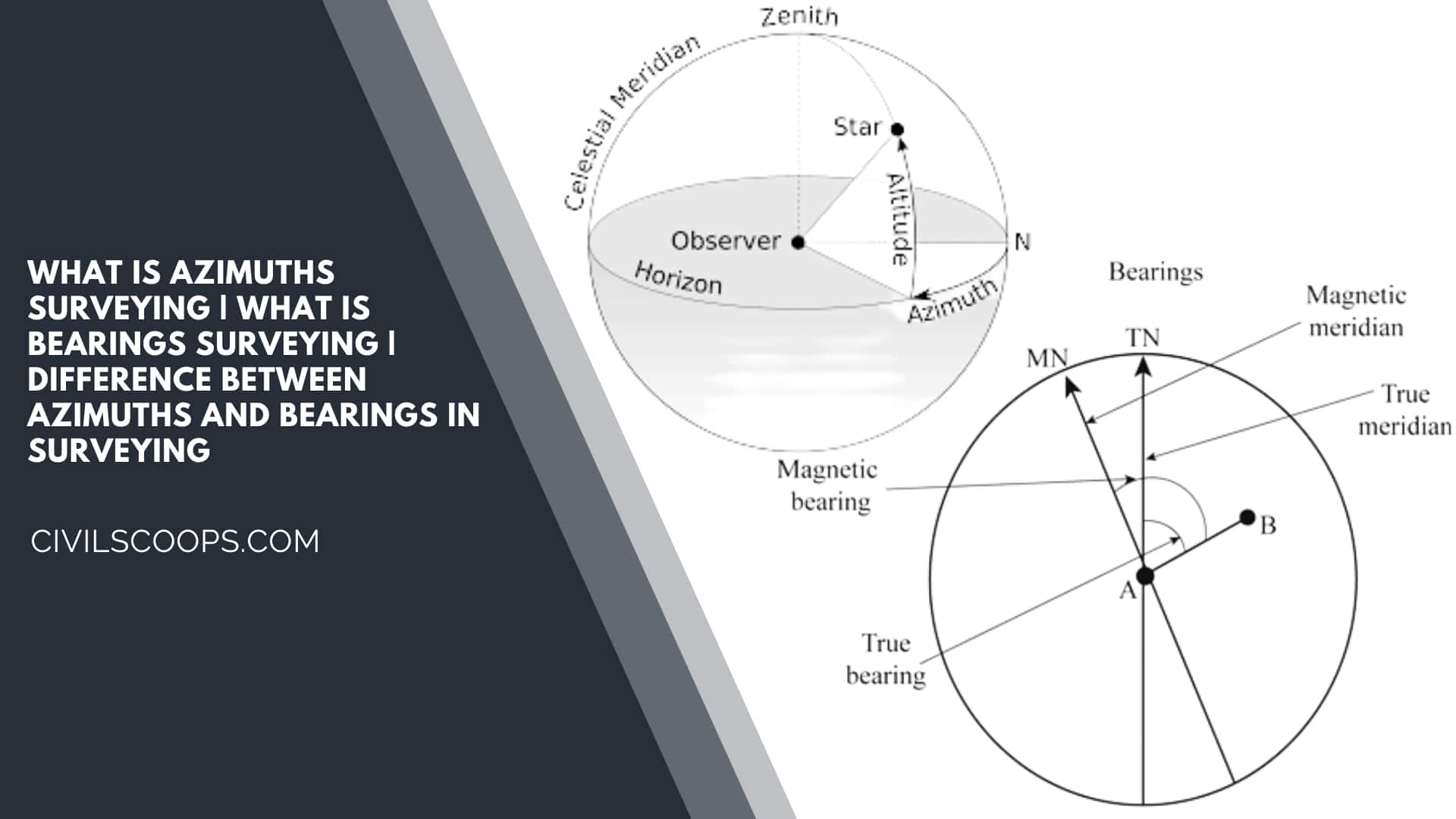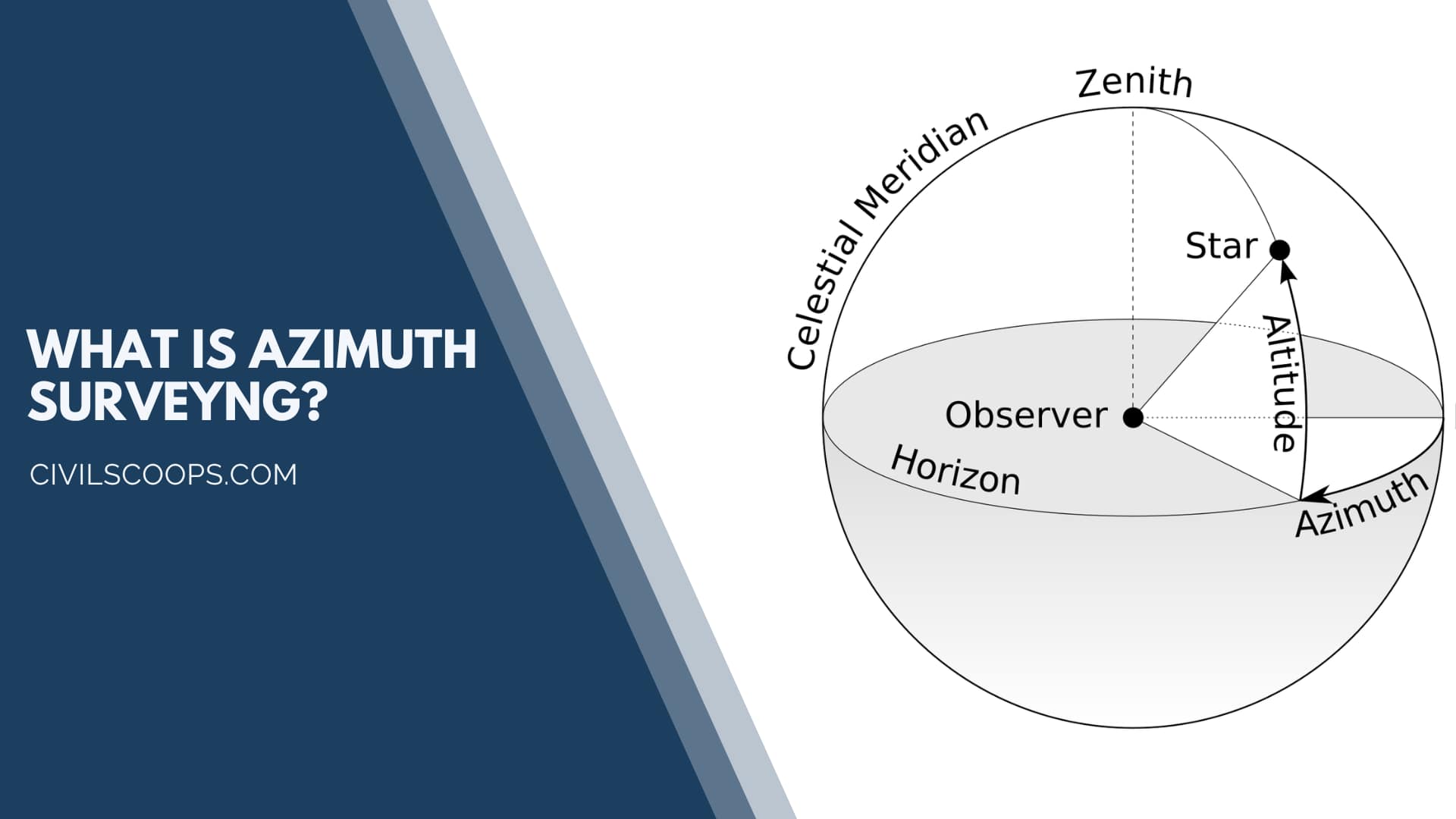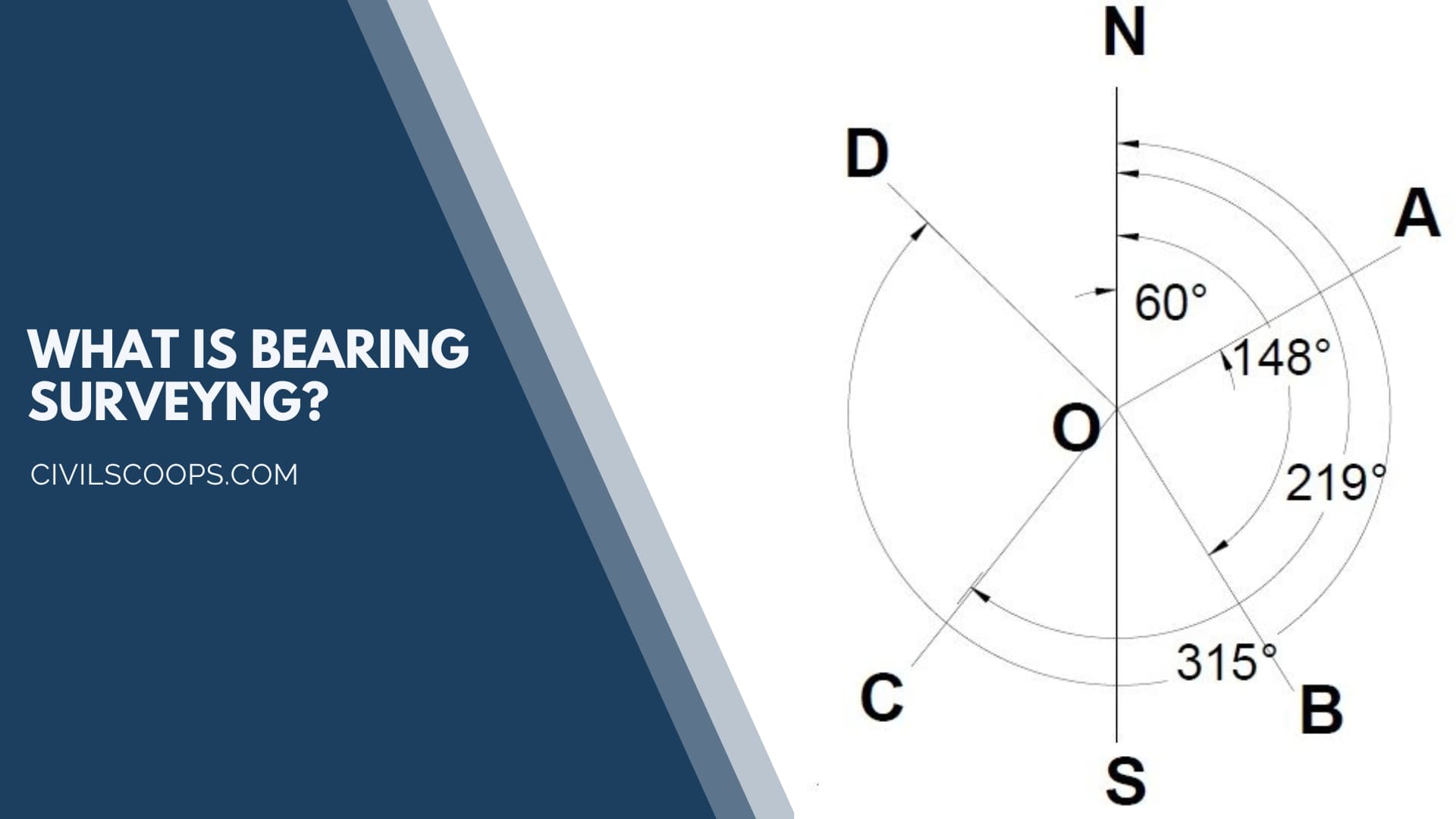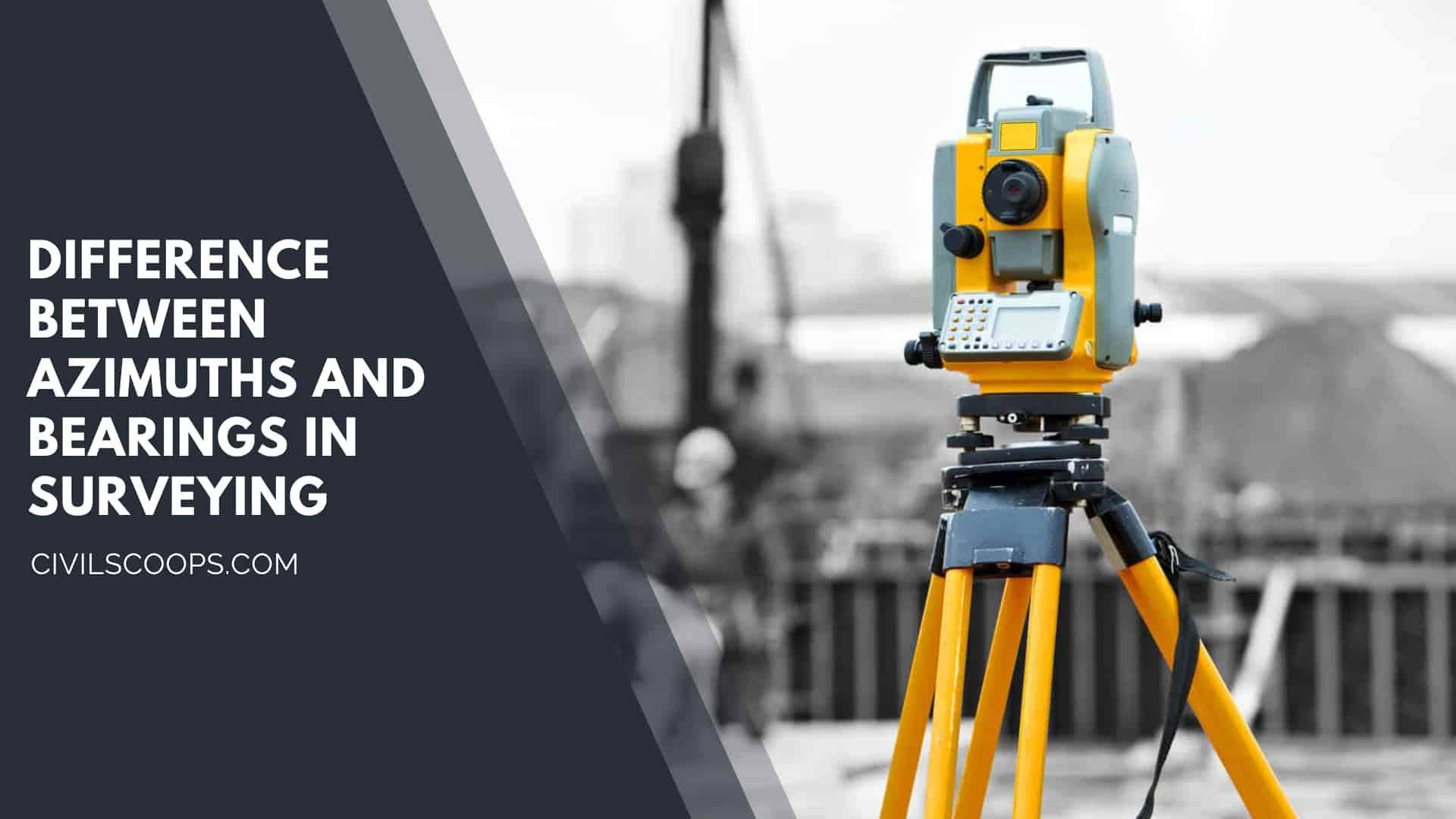What Is Azimuths Surveying | What Is Bearings Surveying | Difference Between Azimuths and Bearings in Surveying

Table of Contents
What Is Azimuths Surveying?

Azimuths are defined as horizontal angles that are measured from the reference meridian in a clockwise direction.
Azimuths are also called whole circle bearing systems (W.C.B). Azimuths are used in compass surveying, and plane surveying, where it is generally measured from the north.
What Are Bearings Surveying?

In land surveying, a bearing is a clockwise or counterclockwise angle between north or south and a direction. In surveying, bearings can be referenced to true north, magnetic north, grid north (the Y-axis of a map projection), or a previous map, which is often a historical magnetic north.
Difference Between Azimuths and Bearings in Surveying

1. Azimuths Surveying Vs Bearings Surveying: Definitions
Azimuths Surveying:
Azimuths are horizontal angles computed in a clockwise manner from the reference meridian. Azimuths are often referred to as a whole circle-bearing system (W.C.B).
Azimuths are used in compass surveying and aircraft surveying and are typically measured from the north. Azimuths are obtained from the south in astronomical and the army.
Bearings Surveying:
The bearing is the acute angle measured between the reference meridian and the given line. The line is measured from north or south to east or west, yielding an angle of fewer than 360 degrees.
The angle is denoted by the letters N or S, followed by the angle value and the E or W direction.
2. Azimuths Surveying Vs Bearings Surveying: Types of Azimuth in Surveying
Azimuths Surveying:
The azimuths may be geodetic, astronomic, inferred, recorded, or magnetic in nature, depending on the meridian adopted. It is often recommended to state the comparison meridian before beginning surveying actions to avoid future misunderstandings.
Policy Azimuths:
For work-related purposes, azimuths must be interpreted as north.
Astronomic Azimuths: A azimuth calculated from the astronomical pole in a manner perpendicular to the direction of gravitational at the observation point. Celestial measurements are used to calculate astronomic azimuths.
Geodetic Azimuths:
A reference to the pole of a spheroid in a plane perpendicular to the spheroid at the start or end of a line. The Laplace correction can be used to calculate geodetic azimuths from astronomic azimuths.
Imagine the minor adjustment required in an instrument to keep it leveled over a point if the plumb line is deflected to visualize the difference between astronomic and geodetic azimuths (deflection of the vertical). This minor adjustment will result in a correspondingly minor change in the measured angle.
Grid Azimuths:
The angle in the plan projection between the grid north and the straight line from the point of observation to the point observed is known as the grid azimuth. Only when the point of observation is on the central meridian is grid azimuth the same as geodetic azimuth.
Bearings Surveying:
The bearing of a line is its direction compared to a specified meridian.
True Meridian:
The true meridian along a line is defined as a line in which a plane aligns the earth’s surface after passing via the true north as well as south extremes As a result, it traverses the true north as well as the south. Astronomical studies can be used to determine the true meridian’s path via a point.
True Bearing:
it is a line that is in the horizontal angle formed by this with the true meridian through those lines’ poles. The true bearing of a line is a consistent amount because the path of the true meridian via a point remains intact.
Magnetic Meridian:
A magnetic bearing is measured from a suitable magnetic meridian, a grid bearing from a suitable grid meridian, inferred bearings from a suitable arbitrary meridian, a geodetic bearing from a geodetic meridian, and an astronomic bearing from an astronomic meridian. Observing the needle of the compass yields the magnetic meridian.
Magnetic Bearing:
The magnetic bearing of a line is the horizontal angle formed by the magnetic meridian passing through one of the line’s extremities. It is measured with a magnetic compass.
Arbitrary meridian: Any convenient direction towards a permanent and important mark or signal, such as a church spire or the top of a chimney, is an arbitrary meridian.
These meridians are used to calculate the relative positions of lines in a small area.
Arbitrary Bearing:
The horizontal angle is formed by a line with any arbitrary meridian passing through one of its extremities. It is measured using a theodolite or sextant.
Also Read: What Is Plastering | What Is Pointing | Difference Between Plastering and Pointing |
3. Azimuths Surveying Vs Bearings Surveying: Method of Correcting
Azimuths Surveying:
Method of correcting the azimuth in surveying.
A technique for correcting an electronic compass’s azimuth error is revealed.
- While spinning the electronic compass 360 degrees, measure a declination value corresponding to a predetermined azimuth angle.
- Use a sine function to fit the measured declination value.
- Demonstrate a sinusoidal function.
- Applying offset, amplitude, and azimuth corrections to the displayed sinusoidal function.
Bearings Surveying:
Method of correcting the bearing in surveying.
There are two methods of correcting the bearing affected by local attraction:
Included Angle Method:
The traverse’s incorporated angles are determined at first, trailed by the traverse’s right bearings, which are determined to use the included angles again starting from the line that is unaltered by neighborhood fascination.
Error Computation Method:
At each survey station, the direction and amount of local attractions are determined. Beginning with a line that is not influenced by local attraction, the corrected bearing of the traverse is calculated. This method is more precise than the included angle method. It is used by the majority of surveyors.
4. Azimuths Surveying Vs Bearings Surveying: Applications
Azimuths Surveying:
Azimuth applications in surveying.
- Azimuth is used in boundary, control, and topographic surveys, among other things.
- Azimuths are used in compass and aircraft surveying.
Bearings Surveying:
- A ‘bearing’ is normally calculated in a clockwise direction starting from a reference direction of 0° and increasing to 359.9 degrees in land navigation.
- In aircraft navigation, an angle is commonly measured clockwise from the aircraft’s track or heading.
- In naval navigation, starboard bearings are referred to as ‘green,’ while port bearings are referred to as ‘red.
5. Azimuths Surveying Vs Bearings Surveying: Forward and Back
Azimuths Surveying: Forward and Back Azimuths
- The forward azimuth of the line along whereby the poll is being conducted in the forward azimuth, as well as the reversing azimuth, is the backward azimuth. Throughout the instance of azimuth, the values for forwarding and backward azimuth would be varied. The backward and forward azimuths can be measured by multiplying or deducting 180°.
- If the forward azimuth is much less than 180°, the backward azimuth is calculated by adding 180° to the forward azimuth. If the forward azimuth is larger than 180°, deduct 180° to get the backward azimuth.
Forward azimuth indicates the line’s forward direction, and backward azimuth indicates the line’s backward direction. By adding or subtracting 180 degrees, the forward azimuth may be shifted to the back azimuth. - If line AB has a forward azimuth of 70 degrees, then the backward azimuth would be 70 + 180 = 250 degrees. If the line AD’s azimuth is 230 degrees, the backward azimuth is 230 – 180 = 50 degrees.
Bearings Surveying: Forward and Back Bearings
- The forward bearing of a line is the bearing of a line in the direction in which a survey is advancing. Back bearing refers to the bearing of the line in the opposite direction of progress. Forward bearings can be converted to back bearings and vice versa in aircraft surveying.
- Both the forward and back bearing values will be the same, but the direction will be opposite. The direction will shift from N or S to S or N, and from E or W to W or E
Computation of Azimuths and Bearing in Surveying
[su_table responsive=”yes” alternate=”no”]
| Sr.No. | Quadrant | Detail |
| 1 | Quadrant 1 | North–East Direction: Bearing equals Azimuth |
| 2 | Quadrant 2 | South-East Direction: Bearing = 180° – Azimuth; Azimuth = 180° – Bearing. |
| 3 | Quadrant 3 | South–West. Direction : Bearing = Azimuth – 180°, Azimuth =Bearing + 180° |
| 4 | Quadrant 4 | North – West Direction: Bearing = 360° – Azimuth, Azimuth = 360° – Bearing |
[/su_table]
Designations of Azimuth and Bearings in Surveying
- Back Bearing (BB): Backward Bearing refers to bearings measuring in the opposite way of surveying progress, namely in the backward direction of the survey line.
- Fore Bearing (FB): Bearings measured when surveying, i.e. in the forward direction of survey lines, are referred to as bearings or forward bearings.
- Calculated Bearing: The bearings computed from field observations are referred to as calculated bearings.
- Observed Bearing: The bearings taken in the field with an instrument are referred to as Observed Bearings.
- Whole Circle Bearing: Bearings measured clockwise from the north are referred to as full circle bearings. The value ranges between 0 and 360 degrees. Bearings measured from the north or south towards the east or west, whichever is closer, are known as diminished bearings. For each quadrant, the values range from 0 to 90 degrees. It is often referred to as quadrantal bearing (QB).
[su_box title=”FAQ” style=”default” box_color=”#333333″ title_color=”#FFFFFF” radius=”3″ class=”” id=””]
Azimuth Meaning
When specifying directions, as is done in the preparation of a property survey, angles may be specified as bearings or azimuths. A bearing is an angle less than 90° within a quadrant defined by the cardinal directions. An azimuth is an angle between 0° and 360° measured clockwise from North.
Moon Azimuth
98.7°
Grid Azimuth
the angle between the grid. north and a line is drawn. on the map
Zenith Azimuth
The solar azimuth and solar zenith express the position of the sun. The solar azimuth is the angle of the direction of the sun measured clockwise north from the horizon. The solar zenith is the angle measured from the local zenith and the line of sight of the sun.
Grid to Magnetic Azimuth
A typical note may read “To convert a magnetic azimuth to grid azimuth, subtract G-M angle.” If you have a magnetic azimuth of 270 degrees, and the G-M angle is 8 degrees, your grid azimuth will be 262 degrees
Azimuth Astronomy
The azimuth is the angle between the North, measured clockwise around the observer’s horizon, and a celestial body (sun, moon). It determines the direction of the celestial body. For example, a celestial body due North has an azimuth of 0º, one due East 90º, one due South 180º, and one due West 270º.
Magnetic to Grid Azimuth
A typical note may read “To convert a magnetic azimuth to grid azimuth, subtract G-M angle.” If you have a magnetic azimuth of 270 degrees, and the G-M angle is 8 degrees, your grid azimuth will be 262 degrees
Quadrant to Azimuth
If a strike line is parallel to the North-South direction use N0E or N0W as a quadrant (both are equivalent), or 000 for azimuth. If a strike line is parallel to the East-West direction use N90E or N90W as a quadrant (both are equivalent), or 090 or 270 for azimuth.
Find Azimuth
Most noteworthy, one must make use of the following formula for the purpose of azimuth calculation to the west: Z = 360 – d, where “Z” is the azimuth one intends to find, and “d” is the distance in the form of degrees from due north
Measuring Azimuth
An azimuth is a direction measured in degrees clockwise from the north on an azimuth circle. An azimuth circle consists of 360 degrees. Ninety degrees correspond to the east, 180 degrees is south, 270 degrees is west, and 360 degrees and 0 degrees mark north.
Azimuth Conversion
To compute a back azimuth from an azimuth, simply add or subtract 180 degrees to or from your original azimuth. Remember that a circle has 360 degrees, so if your azimuth is greater than 180 degrees, adding 180 degrees to determine your back azimuth will give you an azimuth that is more than 360 degrees
Sun Azimuth
The solar azimuth angle is defined as the angle between the projection of the sun’s center onto the horizontal plane and due south direction.
Back Azimuth
Back azimuths are calculated as follows: If the original azimuth is less than 180 degrees you ADD 180 degrees to the original azimuth, thus an azimuth of 45 degrees (<180) will have a back azimuth of 225 degrees. If the original azimuth is greater than 180 degrees you SUBTRACT 180 degrees from the original azimuth
Altitude Azimuth
Altitude is the angular distance of an object above the local horizon. It ranges from 0 degrees at the horizon to 90 degrees at the zenith, the spot directly overhead. Azimuth is the angular distance of an object from the local North, measured along the horizon.
True Azimuth
Today, the reference plane for an azimuth is typically true north, measured as a 0° azimuth, though other angular units (grad, mil) can be used. Moving clockwise on a 360-degree circle, the east has azimuth 90°, the south 180°, and the west 270°. There are exceptions: some navigation systems use the south as the reference vector.
Roof Azimuth
The roof azimuth angle is the azimuth angle of the equivalent wall. For example, increase the tilt angle until it is vertical and it is the orientation looking out from inside. A horizontal roof has an azimuth angle of 0o and a tilt angle of 0o.
Satellite Azimuth
Azimuth and Elevation are measures used to identify the position of a satellite flying overhead. Azimuth tells you what direction to face and Elevation tells you how high up in the sky to look. Both are measured in degrees. Azimuth varies from 0° to 360°.
Solar Azimuth
The solar azimuth angle is defined as the angle between the projection of the sun’s center onto the horizontal plane and due south direction.
Azimuth Satellite Dish
In essence, Azimuth is simply the compass heading to point the antenna (dish) toward. The elevation is the angle between the beam pointing direction, directly towards the satellite, and the local horizontal plane. It is the up-down angle. Simply it is how high from the horizon the satellite is (90° is vertical).
True Bearing and Magnetic Bearing
True bearing and magnetic bearing in geography generally refer to true north and magnetic north. True north is the direction pointing to the North Pole. On the map, true north is represented by meridians or lines of longitudes. On the other hand, magnetic north is the direction that points to the magnetic pole
True Bearing in Surveying
If the north used as reference is the true geographical north then the bearing is a true bearing whereas if the reference used is magnetic north then the bearing is a magnetic bearing. An absolute bearing is measured with a bearing compass.
True Bearing and Relative Bearing
Relative Bearing + Ship’s Heading = True Bearing. If you have a relative bearing of 020° and a ship’s heading of 090° then the true bearing to the target is 110° (20 + 90 = 110). If R+S=T is true, then simple math tells you that T-S=R must also be true.
True Bearing Example
Compass bearings use the four directions on a compass in order to find the direction of one object from another. An example is N20°E. True bearings use the number of degrees measured clockwise from the north of an object. An Example is 120°T
Quadrantal Bearing
A horizontal angle bearing less than 90 degrees, measured to north, south, east, or west from a survey line.
Whole Circle Bearing
The horizontal angle made by a line with the magnetic north in the clockwise direction is the whole circle bearing the line. This system is also known as the azimuthal system. In this system, only the north direction is used as the reference meridian.
Bearing Calculation Formula
Use the angle fact that angles in a full turn add to 360°. To work the bearing, subtract 130° from 360°. 360° – 130° = 230° and so, the bearing of A from B is 230°.
Journal Bearing Clearance Formula
If we take the bearing diameter as D and journal diameter as d, the formula to calculate bearing clearance is c = D-d. The bearing clearance to journal radius ratio is called relative bearing clearance. It is usually shown as y in the bearing design, and it is calculated as y = (D-d)/d.
Bearing Dynamic Load Calculation
Calculation of dynamic equivalent load
When Fa/Fr≦e for single-row radial bearings, it is taken that X=1, and Y=0. Hence, the dynamic equivalent load rating is Pr=Fr. …
For single-row angular contact ball bearings and tapered roller bearings, axial component forces (Fac) are generated
Bearing Load Formula
If Fa/Fr>e then the equivalent bearing load P is calculated using P=XFr+YFa where X and Y depend on the type of bearing
Thrust Bearing Calculation
BASIC FORMULAS
Pa = XFr + YFa; X and Y – coefficients, depending on the ratio Fa / Fr and on contact angle; Nominal bearing life: L10 = (Сa / Pa) 3.
Fore Bearing
Bearings measured in the direction of progress of the survey are known as fore bearings and bearings measured opposite to the direction of the survey are known as a back bearings. The bearing of a line is the direction with respect to a given meridian; a Meridian is a fixed reference line
Forward Bearing and Back Bearing
Fore Bearing – Bearing is measured in the direction of the progress of the survey. Back Bearing – Bearing measured opposite to the direction of the survey
Back Bearing Navigation
The back bearing may be calculated by adding or subtracting 180° from the forward bearing. The result must fall between 0° and 360°, so if the forward bearing is less than 180°, add 180° to it, or if it’s greater than 180°, subtract 180°
[/su_box]
[su_note note_color=”#F2F2F2 ” text_color=”#333333″ radius=”3″ class=”” id=””]
Like this post? Share it with your friends!
Suggested Read –
- All About Sand | What Is Sand | 29 Types of Sand | Composition of Sand
- 19 Different Types of Slabs in Construction | What Is a Slab | Types of Slabs
- All About Gypsum Plaster | What Is Gypsum Plaster | 15 Advantage of Gypsum Plaster | Disadvantages of Gypsum Plaster
- All About M Sand | What Is M Sand | Properties of Manufactured Sand | Advantages & Disadvantages of Manufactured Sand
- All About Uscs | Which Test Gives a Better Estimation of the Friction Angle | Introduction of USCS ( Unified Soil Classification System )
[/su_note]
Originally posted 2023-02-25 13:22:49.

